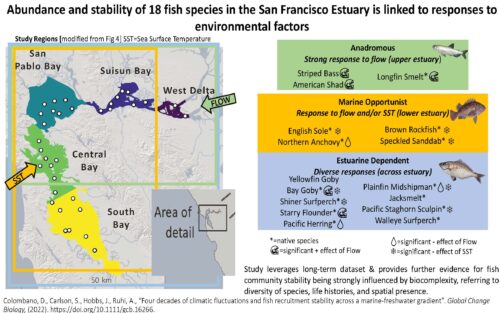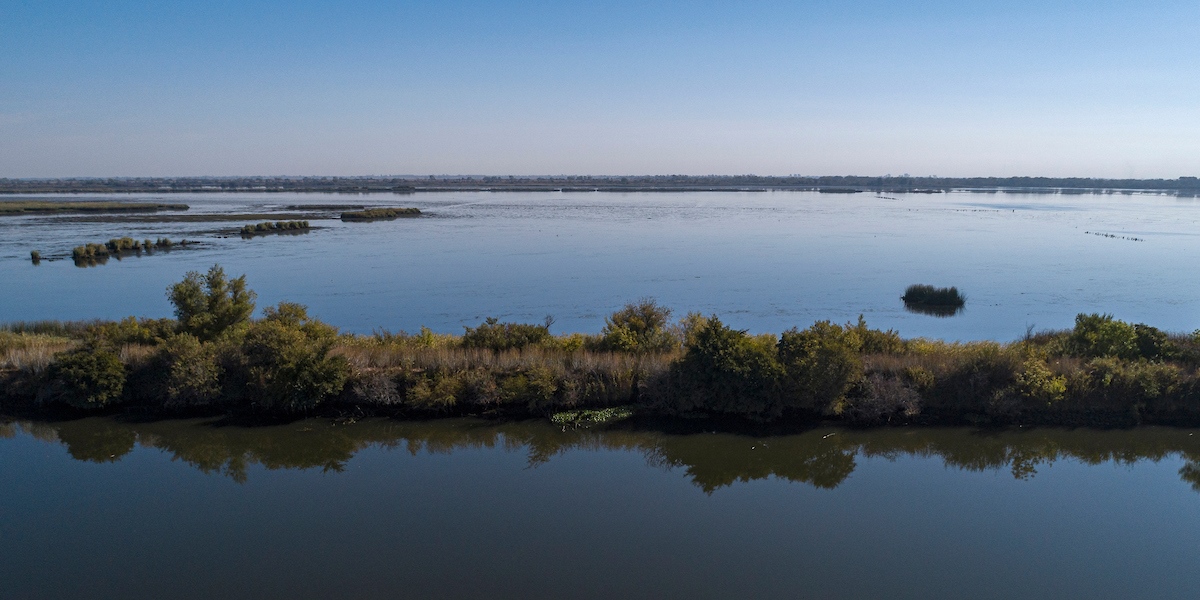At the July meeting of the Delta Stewardship Council, Delta Lead Scientist Dr. Laurel Larsen presented the results of a synthesis study using multiple fish surveys, implementation of the 2022-26 Science Action Agenda, and peer review of the Sacramento River Water Temperature Modeling Platform.
Research spotlight: Analyzing the abundance and stability of 18 fish species in the San Francisco Estuary using multiple fish surveys
 Dr. Larsen’s research spotlight was on a paper co-authored by two-time Delta Science Fellow Dr. Denise Columbano that was recently published in the journal, Global Change Biology. The paper describes a synthesis study that leveraged four decades of monitoring data from multiple fish surveys to analyze how different fish species have changed in abundance over time, once you control for their variability over space. The study also considered how precisely interacting factors control the abundance and stability of fish communities.
Dr. Larsen’s research spotlight was on a paper co-authored by two-time Delta Science Fellow Dr. Denise Columbano that was recently published in the journal, Global Change Biology. The paper describes a synthesis study that leveraged four decades of monitoring data from multiple fish surveys to analyze how different fish species have changed in abundance over time, once you control for their variability over space. The study also considered how precisely interacting factors control the abundance and stability of fish communities.
“This work is important because it helps us to understand how levers that we can control, such as inflows to the Delta, as well as those we can’t but that are important to anticipate, such as changing sea surface temperature, might impact fish abundance,” said Dr. Larsen. She noted this research addresses Management Need 5 of the 2022-26 Science Action Agenda, which calls for analysis and synthesis of the impact of interacting stressors on species recovery and ecosystem health, and Action 6A, which calls for evaluating how climate change will impact long-term species persistence.
In this study, Dr. Columbano asks two important questions. The first question is, how does juvenile fish abundance vary over space and time in response to freshwater flows and sea surface temperatures? To answer this question, the research team used statistical models to look at how trends in abundance varied among categories of species with different life strategies, including anadromous species that hatch in the tributaries of the Delta and migrate to the ocean to complete the intermediate portion of their lifecycle. They also looked at marine opportunists who can migrate to the ocean to take advantage of favorable conditions but otherwise live in the estuary, and estuarine species, which depend on the Bay-Delta estuary.
“The team found that anadromous species tend to be found in the upper estuary, and they decrease in abundance with lower freshwater flows,” Dr. Larsen said. “They also found that anadromous longfin smelt and striped bass have been decreasing over time. In contrast, marine opportunists, who are more abundant in the lower estuary, have been increasing in abundance over time. Their populations tend to go up with lower freshwater flows, opposite to the anadromous species; they also tend to go up with higher sea surface temperatures. Meanwhile, estuarine-dependent species were found throughout the estuary, and they exhibited various responses to flow and sea surface temperature that were really species specific.”
The second question was whether the diversity of species, life history strategies, and species distribution led to the fish community’s stability overall. In other words, do any or all of the types of diversity buffer fish communities from fluctuations that they might experience in any location or within any species? Based on this statistical modeling, the team concluded that the answer to those questions was yes.
Dr. Larsen then gave the implications for management. “In periods of drought, such as the one that we’re in currently, these findings provide some insight into how fish communities might respond to the way that we manage the Delta. They suggest that flow pulses during drought may help sustain anadromous species. But on the other hand, the expansion of warmer, saltier water into the system may benefit marine opportunist species, such as anchovies. Historically, prior to water project operations, when the Delta experienced even more variable flow conditions, it’s likely that trade-off type fluctuations among these different categories of species lead to higher stability of the fish community overall.”
The 2022 to 2026 Science Action Agenda
 Since the release and subsequent Council approval of the Science Action Agenda in April, the Delta Science Program has been working to distribute the document widely. Hard copies are now available, and presentations on the Agenda have been made to the Collaborative Science and Adaptive Management Program, the California Water Quality Monitoring Council, the State Water Resources Control Board, and the Delta Plan Interagency Implementation Committee.
Since the release and subsequent Council approval of the Science Action Agenda in April, the Delta Science Program has been working to distribute the document widely. Hard copies are now available, and presentations on the Agenda have been made to the Collaborative Science and Adaptive Management Program, the California Water Quality Monitoring Council, the State Water Resources Control Board, and the Delta Plan Interagency Implementation Committee.
“The Science Program staff and myself have been discussing this document widely within our network to develop a strategy to implement the Science Action Agenda’s priority science actions in a collaborative manner that mirrors the collaborative spirit that went into the development of this document,” said Dr. Larsen. “So there are conversations underway between the science program and some of our funding partners about how we might be more collaborative, at least at the outset, of calls for competitive funding.”
There is discussion underway about forming a workgroup and instituting a pre-proposal process through which investigators would submit their ideas for proposals to a multi-agency group of potential funders. This would provide an opportunity to direct them to the most appropriate funding programs among the different agencies and could potentially solve fiscal year incompatibilities between the agencies.
“As a reminder, funding competitive research, as well as directed research, is a primary mechanism for implementing the science action agenda,” said Dr. Larsen.
Sacramento River Water Temperature Modeling Platform Peer Review
On July 19-20, 2022, the Delta science program convened an independent review panel to evaluate the Bureau of Reclamation’s water temperature monitoring platform for the Shasta-Keswick-Sacramento River system. It was a hybrid panel with some panelists in-person and others remote.
This is the first of two reviews to be conducted through a contract with the Bureau of Reclamation. The second, tentatively scheduled for the fall of 2023, will assess the water temperature modeling platform for the American River and Stanislaus systems and the Central Valley Project.
“This review has important management implications,” said Dr. Larsen. “Many of the listed fish species in our estuary are at the southern extent of their range, meaning they are quite sensitive to water temperatures. So as we look to the future, water temperature is going to be one of the limiting factors that control the abundance or even the persistence of some of these fish species in our estuaries.”
“It’s something that we also have limited control over through the way in which we operate Delta reservoirs and the cold water pools deep within those reservoirs,” she continued. “The Bureau of Reclamation has really been forging new ground in developing a comprehensive water temperature modeling platform. I’ve heard others say that this could be an example that other estuaries or aquatic systems in different parts of the country might look to as they begin to face similar challenges associated with warmer temperatures and climate change.”
The review is an opportunity to give Reclamation feedback on the technical aspects of the modeling platform to improve the modeling tools currently used to predict temperatures for dam operations and develop seasonal temperature management plans for planning studies.
This advisory panel was designed to give feedback on projects at earlier stages of development. The selected reviewers are completely independent and associated with external universities or agencies. The Delta Lead Scientist has the final say over the reviewers on the panel and provides the set of questions for the panel.
Dr. Larsen said that the panelists were impressed with the water temperature monitoring platform overall and the productivity of the relatively small team at the Bureau of Reclamation that has been devoted to the project. They also had plenty of preliminary feedback, which Reclamation said was quite constructive. The feedback focused on areas of the documentation that needed clarification for purposes of transparency, suggestions on how technical considerations like data gap filling and estimation of inflows might be improved, how methods for testing the performance of the model might be improved, and assessing how errors accumulate across different modeling components. The panel also had many questions for Reclamation requesting clarification that could help them better address their charge questions.
The panel will now produce a review report that will eventually be made publicly available.
A Council member asked if there are other estuaries we can learn from who are also doing water temperature modeling. “My understanding is that we are really setting a precedent here,” said Dr. Larsen. “This estuary is one of the main places where we have listed species at thermal limit already. And California is setting precedents on how we incorporate temperature regulation into the biological opinions for the management of those species. So my understanding is that this water temperature modeling platform is pretty unique to this system, but has a lot of potential to be applied elsewhere, as these water temperature concerns become growing concerns in the other estuaries.”



